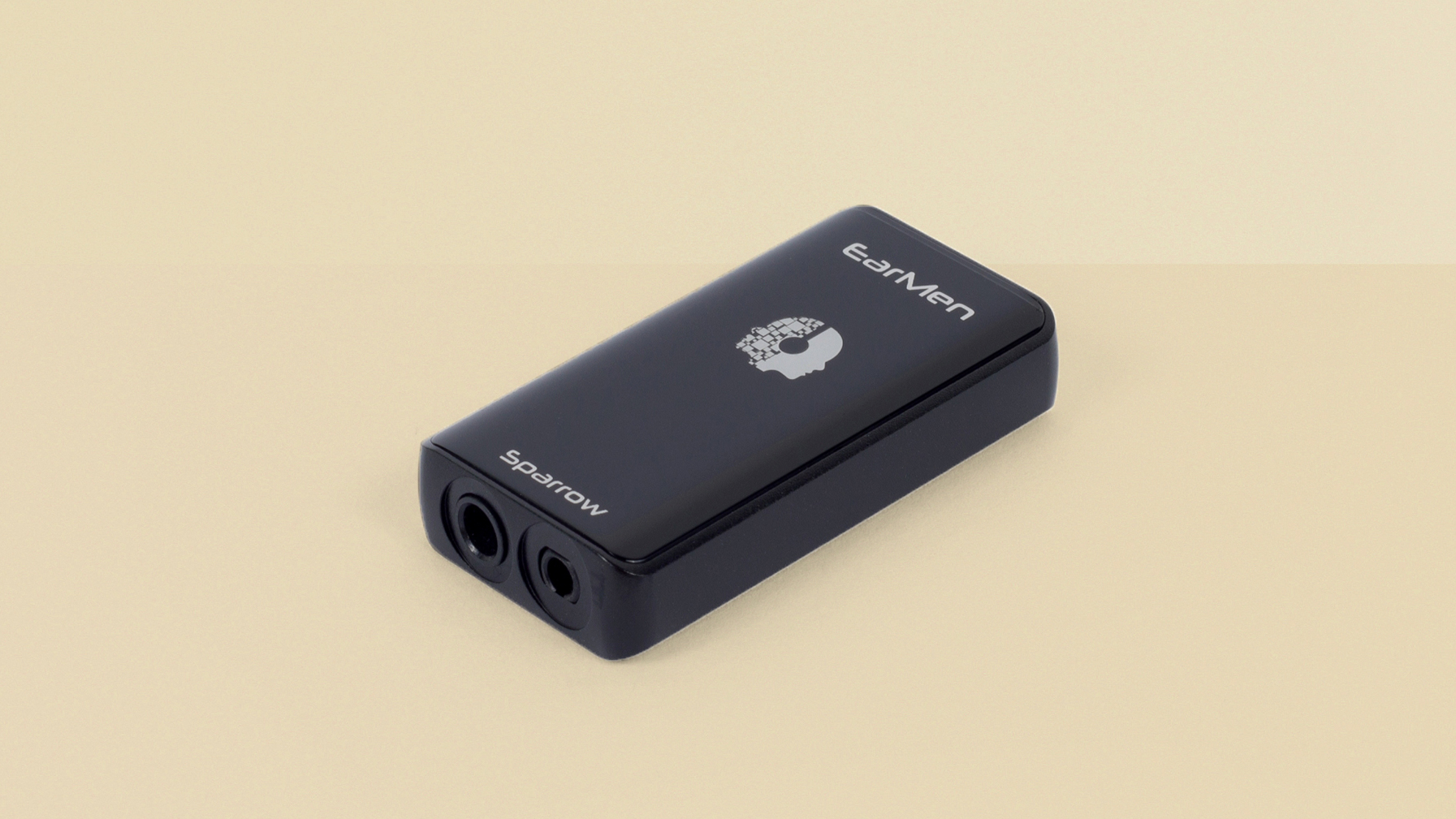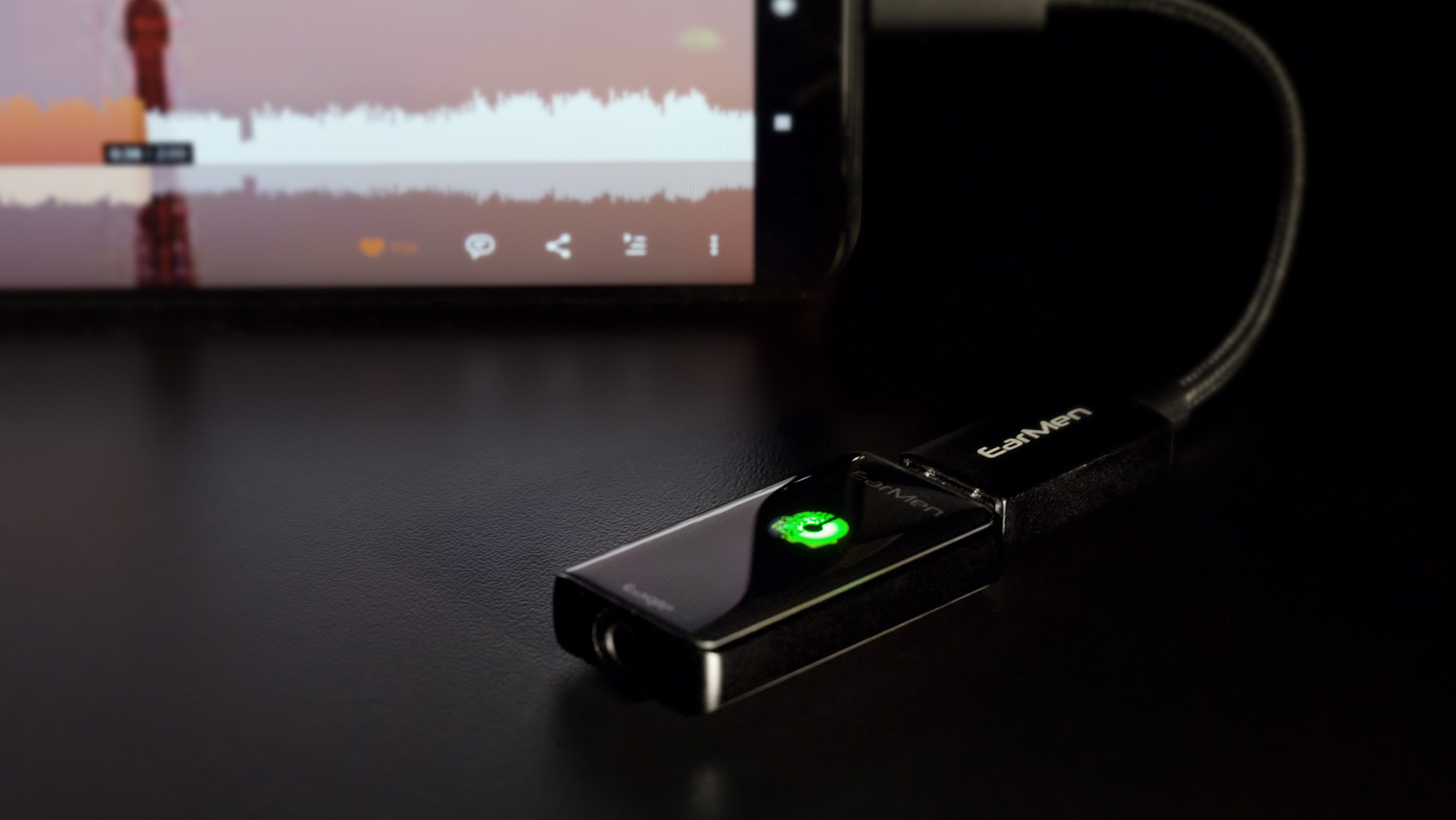EarMen Sparrow review: a portable USB-C DAC and headphone amp with big performance
This tiny USB-C DAC is great for audiophiles with newer smartphones, tablets and laptops to plug in their best headphones


The EarMen Sparrow delivers huge sound improvements in a small package, with useful USB-C connectivity as standard. If you’re only going to do one thing, do it well – and this does it in some style.
-
+
Big, across-the-board sonic improvements
-
+
Small, light and easily portable
-
+
Great specification
-
-
Occasional connectivity niggles
-
-
Strong cheaper competition
Why you can trust T3

This EarMen Sparrow review is looking a truly tiny little USB-C DAC/headphone amplifier. It’s designed to take away all the arduous digital-to-analogue conversion your digital audio files need to undergo before your headphones can understand them. And then, by way of an encore, it amplifies the analogue information before your headphones get to deal with it.
Despite its miniature size – you’ll hardly notice it in your pocket alongside your phone – the Sparrow is extensively specified, with features to stand up against many of the best headphone DACs. It can handle most digital file types, from PCM and DSD to DXD and MQA, and it’s got both 3.5mm unbalanced and 2.5mm balanced headphone outputs. So good luck trying to find audio files or headphones it’s not compatible with.
It’s not as if the EarMen has the field clear, though – quite the opposite. There are any number of compact DAC/headphone amps ready to do the same job for boosting the sound of the best wired headphones, at similar money. So how is the Sparrow to stand out among the flock?
EarMen Sparrow review: Price & release date
The EarMen Sparrow is on sale now, and in the UK can be yours for £189. In the United States that price is $199, while customers in Australia are looking at AU$399 – which, even to long-suffering Australian consumers, is quite the mark-up.
At this sort of money the Sparrow is taking on some established market-leaders from some deeply credible brands. Audiolab’s M-DAC nano, for instance, is a little more affordable and connects wirelessly, while the AudioQuest Dragonfly Red has been winning plaudits for years (though isn't USB-C). If EarMen is going to crash the top table, it’s going to have to perform to an outstanding standard.

EarMen Sparrow review: Features & what's new
Taking the crucial digital-to-analogue conversion process away from interference is far from a novel idea, of course. Digital audio storage devices like laptop computers and smartphones are seldom held up as great music players – after all, they’ve an awful lot of other stuff to get on with, and the digital-to-analogue conversion circuitry and headphone amplification tend to be a) a bit of an afterthought and b) surrounded by a tremendous amount of electrical noise and interference.
In an effort to get the job done properly, the EarMen Sparrow is equipped with a high-performance ES9281Pro DAC chipset from acknowledged master Sabre. So it’s compatible with Android and iOS smartphones, as well as MacOS and Windows computers.
Get all the latest news, reviews, deals and buying guides on gorgeous tech, home and active products from the T3 experts
It’s the first USB DAC that includes an integrated MQA renderer to complete the final ‘unfold’ of those ‘Masters’ files you’re paying a premium TIDAL subscription for. And it can handle all 32bit/384kHz formats, including PCM and DSD128. So if it’s high-resolution audio you’re after, the Sparrow has you covered.
It has more than enough power to drive even quite demanding headphones, yet is a trifling 8x22x42mm, so it’s hardly a burden to carry about. Connection to your smartphone or computer is via the Sparrow’s USB-C input – there are USB-C-to-USB-C and USB-A-to-USB-C cables included, so you can use it with most things straight out of the box.
The only notable exception is iPhones – even though current iPhones come with a Lightning-to-USB-C cable in the box, plugging this straight from the iPhone to the Sparrow doesn't work, because the iPhone isn't designed to work this way. It still requires the use of the Lightning-to-USB-A adapter that Apple sells in order to get any audio from the iPhone. The USB-C-to-C cable works perfectly with newer iPads and MacBooks, of course.
Other than that, the only feature (beyond the ‘MQA’ and ‘Hi-Res Audio’ logos) is an ‘EarMen’ logo that illuminates in a few different colours to let you know what the Sparrow is up to.
EarMen Sparrow review: Performance
First and foremost, the Sparrow needs to be a worthwhile improvement on the unassisted sound served up by your smartphone and/or laptop. And sure enough, the differences between the way a pair of Sennheiser IE900 in-ear monitors sound when hooked directly into a MacBook Air or a Sony Xperia 5 and they way they sound with the EarMen Sparrow doing the heavy lifting is, roughly, similar to the difference between a service-station sandwich and three à la carte courses. Improvements in performance are wide-ranging and significant.
What’s initially most striking is the straightforward increase in volume – the Sparrow’s headphone amplification circuitry simply breathes far deeper than that in the Apple products, and even though the Sennheisers aren’t the easiest IEMs to drive the EarMen put the proverbial rocket up them.
Get over that initial shock though (and perhaps lower the volume a little) and other, less immediate but equally valuable, improvements become apparent. The soundstage the Sparrow presents is wider and better defined. Detail levels are considerably higher, with improvements especially welcome where low-level or transient information is concerned – suddenly you’re aware of low-level harmonic dynamics that simply weren’t audible previously. And there’s greater extension and control of the lowest frequencies, with greater solidity and definition to bass information than before.
Rhythmic expression steps up a notch or two, and the fluidity of tempos is better expressed too. Fundamentally, the Sparrow does a better, more convincing and more robust job of translating that torrent of digital information into an analogue equivalent than your phone or computer has a chance of doing. And these improvements and increases are available no matter if you’re listening to top-of-the-shop high-resolution files or the more prosaic 320kbps stuff from Spotify.
Downsides are very few, and they don’t have anything to do with the sound the Sparrow delivers. Every now and then our review sample decided it wasn’t attached to our laptop at all and a ‘master reset’ (unplugging it and plugging it in again) became necessary – this didn’t happen when connected to a smartphone. Other than that, about the only accommodation required is perceptive: this is quite a lot of money for a very, very small piece of equipment. But be in no doubt, it makes a big difference if you have high-quality headphones.

EarMen Sparrow review: Design & usability
It’s small and absolutely functional, but the EarMen Sparrow nevertheless has undergone some mild ‘designing’. It’s very nicely made and finished, mostly from glass and metal, and the cables it’s supplied with are pleasantly braided. But basically, it’s a very small block containing some expensively specified electronics, with a USB-C input at one end and two headphone outputs at the other.
It follows that ‘usability’ is pretty straightforward. Plug one end of one of the cables into your source player, if it’s a laptop tell it this is how you want the audio information to be routed, and then plug your headphones into the other end. Rocket science it ain’t.
EarMen Sparrow review: Verdict
The EarMen Sparrow is an accomplished and worthwhile little device. The difference it can make to your audio enjoyment is out of all proportion to the size of the product itself, and its size and weight make it beautifully portable.
It’s not short of competition, though, and its occasional glitchiness when attached to a laptop is a minor niggle. But there’s no arguing with its efficacy, and a lot of the competition isn't equipped for USB-C use out of the box, so it definitely deserves a place on your shortlist.
EarMen Sparrow review: Also consider
The Audiolab M-DAC nano is, broadly speaking, a very similar product to the Sparrow, but with a couple of quite important differences. Firstly, it doesn’t have the EarMen’s facility with MQA audio files, and secondly it uses Bluetooth 4.2 to pair wirelessly with your source player. Yes, its battery could do with a little more stamina, but it’s capable of bringing a stack of additional punch, detail and realism to your portable audio experience, and still with some wireless freedom. iPhone users especially might consider this option instead, due to that device's annoying connection foibles.
Simon Lucas is a freelance technology journalist and consultant, with particular emphasis on the audio/video aspects of home entertainment. Before embracing the carefree life of the freelancer, he was editor of What Hi-Fi? magazine and website – since then, he's written for titles such as Wired, Metro, the Guardian and Stuff, among many others. Should he find himself with a spare moment, Simon likes nothing more than publishing and then quickly deleting tweets about the state of the nation (in general), the state of Aston Villa (in particular) and the state of his partner's cat.
